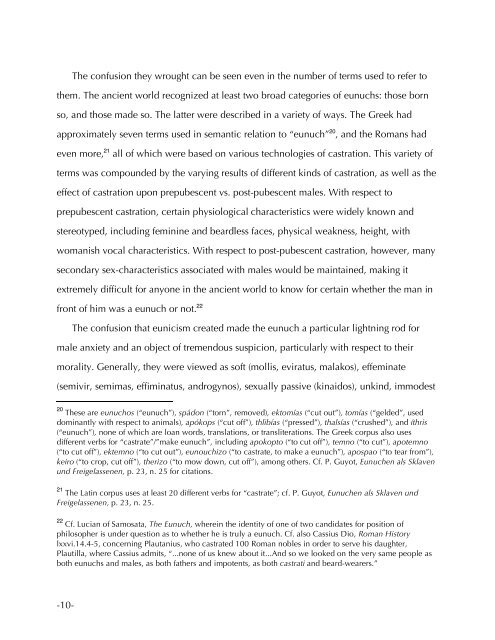-1- Eunuchs and the Postgender Jesus: Matthew 19:12 and ...
-1- Eunuchs and the Postgender Jesus: Matthew 19:12 and ...
-1- Eunuchs and the Postgender Jesus: Matthew 19:12 and ...
Create successful ePaper yourself
Turn your PDF publications into a flip-book with our unique Google optimized e-Paper software.
-10-<br />
The confusion <strong>the</strong>y wrought can be seen even in <strong>the</strong> number of terms used to refer to<br />
<strong>the</strong>m. The ancient world recognized at least two broad categories of eunuchs: those born<br />
so, <strong>and</strong> those made so. The latter were described in a variety of ways. The Greek had<br />
approximately seven terms used in semantic relation to “eunuch” 20 , <strong>and</strong> <strong>the</strong> Romans had<br />
even more, 21 all of which were based on various technologies of castration. This variety of<br />
terms was compounded by <strong>the</strong> varying results of different kinds of castration, as well as <strong>the</strong><br />
effect of castration upon prepubescent vs. post-pubescent males. With respect to<br />
prepubescent castration, certain physiological characteristics were widely known <strong>and</strong><br />
stereotyped, including feminine <strong>and</strong> beardless faces, physical weakness, height, with<br />
womanish vocal characteristics. With respect to post-pubescent castration, however, many<br />
secondary sex-characteristics associated with males would be maintained, making it<br />
extremely difficult for anyone in <strong>the</strong> ancient world to know for certain whe<strong>the</strong>r <strong>the</strong> man in<br />
front of him was a eunuch or not. 22<br />
The confusion that eunicism created made <strong>the</strong> eunuch a particular lightning rod for<br />
male anxiety <strong>and</strong> an object of tremendous suspicion, particularly with respect to <strong>the</strong>ir<br />
morality. Generally, <strong>the</strong>y were viewed as soft (mollis, eviratus, malakos), effeminate<br />
(semivir, semimas, effiminatus, <strong>and</strong>rogynos), sexually passive (kinaidos), unkind, immodest<br />
20 These are eunuchos (“eunuch”), spádon (“torn”, removed), ektomías (“cut out”), tomías (“gelded”, used<br />
dominantly with respect to animals), apókops (“cut off”), thlibías (“pressed”), thalsías (“crushed”), <strong>and</strong> íthris<br />
(“eunuch”), none of which are loan words, translations, or transliterations. The Greek corpus also uses<br />
different verbs for “castrate”/”make eunuch”, including apokopto (“to cut off”), temno (“to cut”), apotemno<br />
(“to cut off”), ektemno (“to cut out”), eunouchizo (“to castrate, to make a eunuch”), apospao (“to tear from”),<br />
keiro (“to crop, cut off”), <strong>the</strong>rizo (“to mow down, cut off”), among o<strong>the</strong>rs. Cf. P. Guyot, Eunuchen als Sklaven<br />
und Freigelassenen, p. 23, n. 25 for citations.<br />
21 The Latin corpus uses at least 20 different verbs for “castrate”; cf. P. Guyot, Eunuchen als Sklaven und<br />
Freigelassenen, p. 23, n. 25.<br />
22 Cf. Lucian of Samosata, The Eunuch, wherein <strong>the</strong> identity of one of two c<strong>and</strong>idates for position of<br />
philosopher is under question as to whe<strong>the</strong>r he is truly a eunuch. Cf. also Cassius Dio, Roman History<br />
lxxvi.14.4-5, concerning Plautanius, who castrated 100 Roman nobles in order to serve his daughter,<br />
Plautilla, where Cassius admits, “...none of us knew about it...And so we looked on <strong>the</strong> very same people as<br />
both eunuchs <strong>and</strong> males, as both fa<strong>the</strong>rs <strong>and</strong> impotents, as both castrati <strong>and</strong> beard-wearers.”


